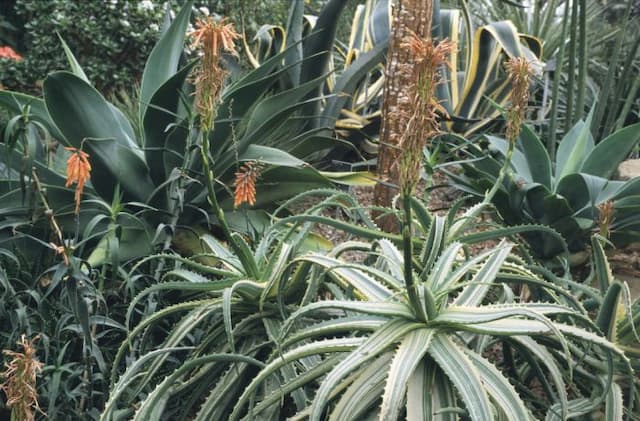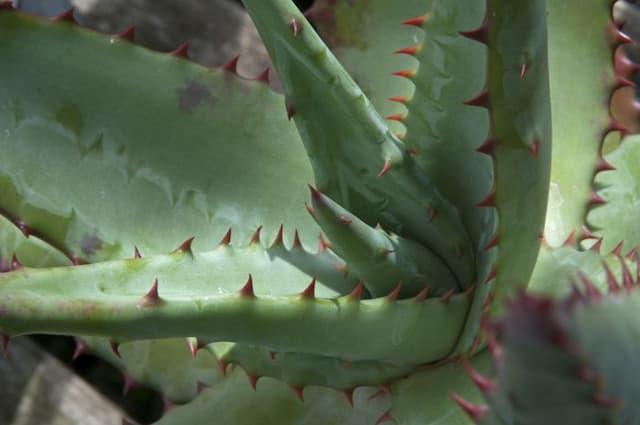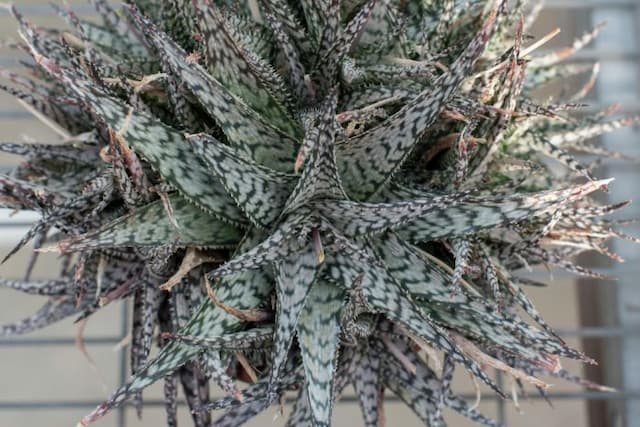Red Hot Poker Kniphofia hirsuta

ABOUT
Known commonly as the Red Hot Poker, the plant is characterized by its striking and vibrant flower spikes that hold a torch-like appearance. The blooms exhibit a range of fiery colors, typically showcasing a gradient from red at the top, transitioning into orange, and then to a creamy yellow towards the bottom. These tubular flowers are densely packed around each of the upright, rounded flower spikes, giving them a luminous effect that is reminiscent of a flickering flame. The foliage of the Red Hot Poker consists of slender, grass-like leaves that are slightly arching, forming a clump from which the flower spikes emerge. The texture of the leaves is often rough, with a fine layer of hair-like structures that can give the leaves a silvery or greyish sheen, adding to the plant’s overall texture. The combination of the vivid flower spikes and the grassy foliage makes the Red Hot Poker a distinctive and eye-catching addition to any garden setting. The plant's ability to bring both color and vertical interest makes it a popular choice for borders and beds where a visual accent is desired.
About this plant
 Names
NamesFamily
Asphodelaceae
Synonyms
Hirsute Poker, Hairy Red Hot Poker, Torch Lily
Common names
Kniphofia hirsuta
 Toxicity
ToxicityTo humans
Red Hot Poker (Kniphofia hirsuta) is not commonly known for its toxicity to humans. There is limited information regarding its ingestion, but it is generally not considered a poisonous plant. However, as with any plant, individual allergic reactions or skin irritation could occur. It is always prudent to avoid ingesting plants that are not known to be safe for consumption.
To pets
Red Hot Poker (Kniphofia hirsuta) is generally not known to be toxic to pets. It is not listed among commonly poisonous plants to dogs, cats, or other domestic animals. However, ingestion of any non-food plant material can potentially cause gastrointestinal upset in pets, such as vomiting or diarrhea. If a pet ingests this plant and exhibits adverse symptoms, it is advised to consult a veterinarian.
 Characteristics
CharacteristicsLife cycle
Perennials
Foliage type
Evergreen
Color of leaves
Green
Flower color
Mixed
Height
2 feet 3 inches [70 cm]
Spread
1 foot 6 inches [45 cm]
Plant type
Herb
Hardiness zones
5
Native area
Southern Africa
Benefits
 General Benefits
General Benefits- Attracts pollinators: Kniphofia hirsuta is known for attracting bees, butterflies, and hummingbirds, which are beneficial for pollination in the garden.
- Drought tolerance: Once established, this plant is quite drought-tolerant, making it suitable for dry or xeriscaped gardens.
- Architectural interest: With its tall, striking flower spikes, Kniphofia hirsuta adds height and visual interest to garden beds and borders.
- Easy to grow: It is relatively easy to grow and maintain, requiring minimal care once established in a suitable location.
- Long blooming period: The plant has a long flowering period which provides color and vibrancy to the garden for an extended time.
- Deer resistance: Kniphofia hirsuta is generally not favored by deer, making it an excellent choice for gardens in areas where deer are a problem.
 Medical Properties
Medical PropertiesThis plant is not used for medical purposes.
 Air-purifying Qualities
Air-purifying QualitiesThis plant is not specifically known for air purifying qualities.
 Other Uses
Other Uses- The Poker Plant's fibrous leaves can be used to make natural twine or rope for garden use, however, they are not as strong or durable as commercially available products.
- Because of their unique shape and color, Kniphofia hirsuta can be integrated into flower arrangements as a source of exotic aesthetic appeal.
- The high nectar production makes Kniphofia hirsuta excellent for attracting hummingbirds and butterflies, serving an important role in supporting local ecosystems.
- Kniphofia hirsuta can be used in landscape design as a structural plant to provide vertical interest with their tall flower spikes standing out among low plantings.
- The dead flower stems of the Poker Plant can be left standing to provide winter interest in a garden, as well as habitats for overwintering insects.
- Poker Plant's ability to tolerate drought conditions makes it an ideal candidate for xeriscaping, reducing the need for frequent watering.
- The distinctive flowers of Kniphofia hirsuta can be used as a natural dye source, although the exact color yield may vary.
- In culinary applications, although not a common practice, the flowers of the Poker Plant could potentially be candied and used as edible decorations on desserts.
- The Poker Plant can be grown as part of a fire-resistant planting scheme in fire-prone regions due to its high moisture content and low flammability.
- The visual appeal of Kniphofia hirsuta can be harnessed in photographic and artistic practices, serving as a vibrant subject for works that highlight natural forms and colors.
Interesting Facts
 Feng Shui
Feng ShuiThe Torch Lily is not used in Feng Shui practice.
 Zodiac Sign Compitability
Zodiac Sign CompitabilityThe Torch Lily is not used in astrology practice.
 Plant Symbolism
Plant Symbolism- Vitality: The fiery and bright appearance of the Red Hot Poker flower suggests a symbol of vitality and energy, reflecting its intense colors and robust growth.
- Attraction: Its unique shape and vibrant colors can symbolize attraction or a beacon that draws attention, representing how the flower can be a focal point in gardens.
- Standing Out: The Red Hot Poker can symbolize standing out or being unique, as its flower spikes stand tall and are easily distinguishable from other plants.
- Passion: The red and orange hues of the flower are often associated with passion and intense emotion, representing strong feelings or enthusiasm.
 Water
WaterThe Red Hot Poker plant requires regular watering, especially during dry spells or in the growing season. It is important to keep the soil consistently moist but not oversaturated. An approximate guideline is to water the plant with about 1 inch of water per week, either through rainfall or supplemental watering. Adults plants can benefit from deep watering which encourages deeper root growth; water the plant until the soil is wet to a depth of about 3 to 4 inches. During the winter or in cooler climates, reduce the frequency of watering as the plant's water requirements decrease.
 Light
LightRed Hot Poker plants thrive best in full sunlight conditions. They need direct sunlight for at least 6 to 8 hours a day to flourish. The ideal spot for these plants is in an area that receives uninterrupted sun throughout the day, as they need ample light to produce their vibrant flower spikes. Partial shade is acceptable, but too much shade can hinder blooming and overall vigor.
 Temperature
TemperatureRed Hot Poker plants are hardy and can tolerate a wide range of temperatures but perform best when the climate is not too extreme. They can survive minimum temperatures down to about 10°F, making them suitable for growing in USDA Hardiness Zones 5 through 9, and they can handle high temperatures as well. The ideal temperature range for these plants is between 50°F and 75°F for optimal growth and flowering.
 Pruning
PruningPruning Red Hot Poker plants is essential to remove spent flower spikes and encourage a second flush of blooms. Cut the flower stems back to the base after flowering. Additionally, in late fall, trim back any dead or damaged foliage to tidy up the plant before winter. Annual pruning should be done in early spring to remove old foliage and promote healthy new growth. Always use clean, sharp tools to make precise cuts.
 Cleaning
CleaningAs needed
 Soil
SoilThe Red Hot Poker (Torch Lily) thrives in well-draining soil with a mix of loam, sand, and compost, ensuring good moisture retention with proper drainage. Its pH preference is slightly acidic to neutral, ranging from 6.0 to 7.0.
 Repotting
RepottingRed Hot Poker plants generally don't require frequent repotting; they should be repotted every 2 to 3 years to refresh the soil and address any crowding issues.
 Humidity & Misting
Humidity & MistingRed Hot Poker plants are tolerant of various humidity levels and don't require specific humidity conditions, making them adaptable to most outdoor garden environments.
 Suitable locations
Suitable locationsIndoor
Ensure full sun and soil that drains well for Red Hot Poker.
Outdoor
Plant in full sun, well-draining soil, and space adequately.
Hardiness zone
5-9 USDA
 Life cycle
Life cycleKniphofia hirsuta, commonly known as Red Hot Poker or Torch Lily, begins its life as a seed which germinates in warm, well-drained soil typically in spring. As a perennial, it then forms a rosette of narrow, grass-like leaves from which emerges a central flowering stalk in the early to mid-summer. The unique, tubular flowers bloom progressively from the bottom to the top of the spike and are pollinated by insects and hummingbirds. After pollination, seeds develop and are dispersed to propagate the next generation. In the fall, foliage may die back, but the plant's roots persist through winter in a dormant state. With the return of favorable conditions in spring, Kniphofia hirsuta resumes growth, completing its perennial cycle.
 Propogation
PropogationPropogation time
Spring-Early Summer
The most popular method of propagating Kniphofia hirsuta, commonly known as Torch Lily or Red Hot Poker, is through division. This is best done in the spring, just as the plants are beginning to grow. To propagate by division, carefully lift the clump of Torch Lily from the ground with a shovel, keeping a good amount of soil around its roots. Using a sharp knife or spade, slice the clump into smaller sections, ensuring that each division has at least one or two healthy growth points. These divisions should then be replanted immediately at the same soil depth they were growing before, spaced approximately 18 inches (about 45 centimeters) apart to allow enough room for growth. Water the newly planted divisions well to help establish them. Division helps to rejuvenate older clumps, encouraging more vigorous growth and flowering.









